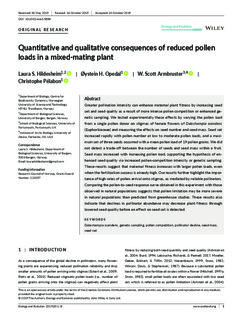| dc.contributor.author | Hildesheim, Laura | |
| dc.contributor.author | Opedal, Øystein Hjorthol | |
| dc.contributor.author | Armbruster, Scott | |
| dc.contributor.author | Pelabon, Christophe | |
| dc.date.accessioned | 2020-01-27T13:48:05Z | |
| dc.date.available | 2020-01-27T13:48:05Z | |
| dc.date.created | 2019-12-17T10:29:06Z | |
| dc.date.issued | 2019 | |
| dc.identifier.issn | 2045-7758 | |
| dc.identifier.uri | http://hdl.handle.net/11250/2638120 | |
| dc.description.abstract | Greater pollination intensity can enhance maternal plant fitness by increasing seed set and seed quality as a result of more intense pollen competition or enhanced genetic sampling. We tested experimentally these effects by varying the pollen load from a single pollen donor on stigmas of female flowers of Dalechampia scandens (Euphorbiaceae) and measuring the effects on seed number and seed mass. Seed set increased rapidly with pollen number at low to moderate pollen loads, and a maximum set of three seeds occurred with a mean pollen load of 19 pollen grains. We did not detect a trade‐off between the number of seeds and seed mass within a fruit. Seed mass increased with increasing pollen load, supporting the hypothesis of enhanced seed quality via increased pollen‐competition intensity or genetic sampling. These results suggest that maternal fitness increases with larger pollen loads, even when the fertilization success is already high. Our results further highlight the importance of high rates of pollen arrival onto stigmas, as mediated by reliable pollinators. Comparing the pollen‐to‐seed response curve obtained in this experiment with those observed in natural populations suggests that pollen limitation may be more severe in natural populations than predicted from greenhouse studies. These results also indicate that declines in pollinator abundance may decrease plant fitness through lowered seed quality before an effect on seed set is detected. | nb_NO |
| dc.language.iso | eng | nb_NO |
| dc.publisher | Wiley | nb_NO |
| dc.rights | Navngivelse 4.0 Internasjonal | * |
| dc.rights.uri | http://creativecommons.org/licenses/by/4.0/deed.no | * |
| dc.title | Quantitative and qualitative consequences of reduced pollen loads in a mixed-mating plant | nb_NO |
| dc.type | Journal article | nb_NO |
| dc.type | Peer reviewed | nb_NO |
| dc.description.version | publishedVersion | nb_NO |
| dc.source.journal | Ecology and Evolution | nb_NO |
| dc.identifier.doi | 10.1002/ece3.5858 | |
| dc.identifier.cristin | 1761682 | |
| dc.relation.project | Norges forskningsråd: 223257 | nb_NO |
| dc.description.localcode | © 2019 The Authors. Ecology and Evolution published by John Wiley & Sons Ltd. This is an open access article under the terms of the Creative Commons Attribution License, which permits use, distribution and reproduction in any medium, provided the original work is properly cited. | nb_NO |
| cristin.unitcode | 194,66,10,0 | |
| cristin.unitname | Institutt for biologi | |
| cristin.ispublished | false | |
| cristin.fulltext | postprint | |
| cristin.qualitycode | 1 | |

